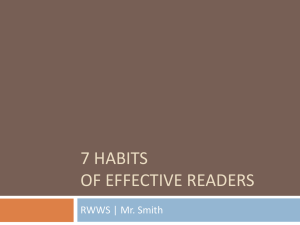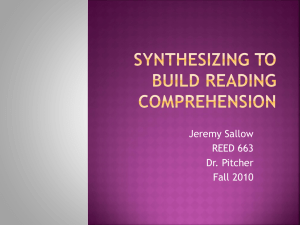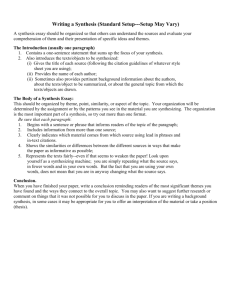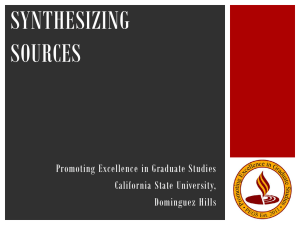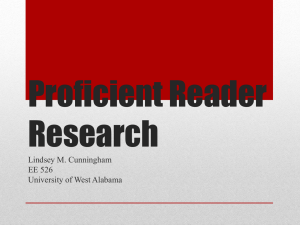Synthesizing Text - Wayland Public Schools
advertisement
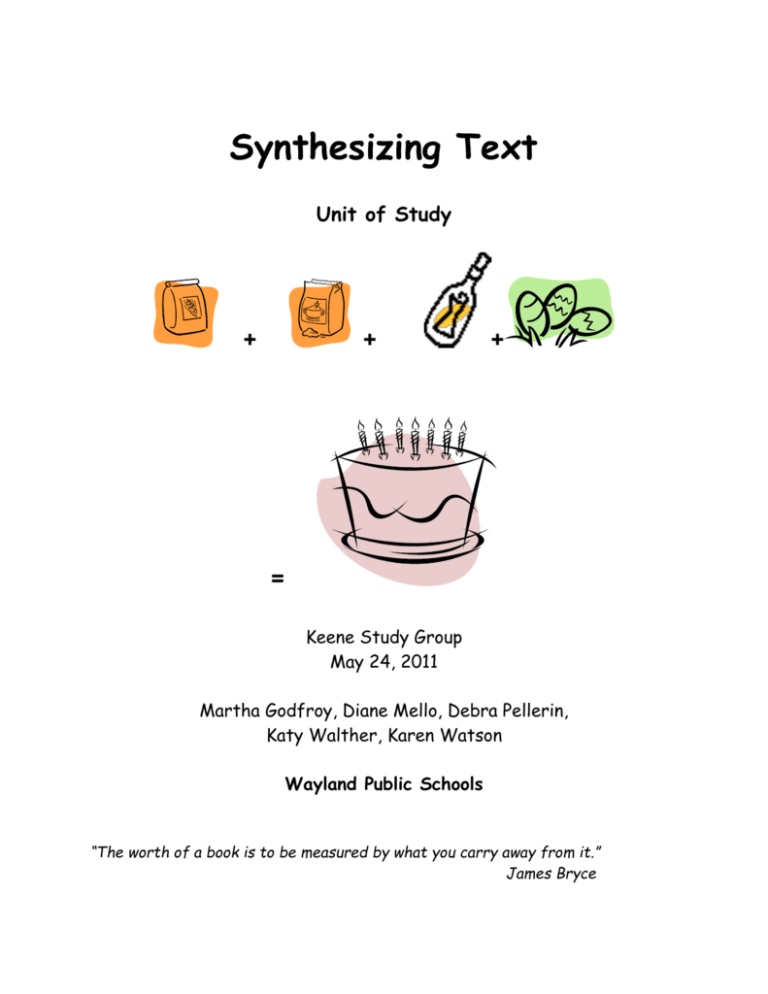
Synthesizing Text Unit of Study + + + = Keene Study Group May 24, 2011 Martha Godfroy, Diane Mello, Debra Pellerin, Katy Walther, Karen Watson Wayland Public Schools “The worth of a book is to be measured by what you carry away from it.” James Bryce Unit of Study: Synthesizing Text Key Understandings ● Readers monitor overall meaning, important concepts and themes as they read, understanding that their thinking evolves in the process ● Readers retell what they have read as a way of synthesizing ● Readers synthesize to understand more clearly what they have read, pulling all of their strategies together ● Readers extend their synthesis of the literal meaning of a text to the inferential level ● Readers capitalize on opportunities to share, recommend, and criticize books they have read (From Debbie Miller as adapted from Keene and PEBC) Synthesizing Text Page 2 Unit of Study: Synthesizing Text Unit Outline Focus Lessons: The following are essential focus lessons for teaching Synthesis. Select those lessons that are most appropriate for your grade level. 1. Introducing synthesis: What is synthesis? How does it help you as a reader? 2. Modeling synthesis: How is synthesis different from summary? 3. Synthesizing Fables – grade 1-2 4. Synthesizing Fables – grade 3-5 5. Synthesizing Nonfiction – grade 3-5 6. Applying Synthesis to a Chapter Book (small group lesson) grades 2-5 Appendix: 7. Template for additional lessons 8. Synthesis journal entry options a. Chart with spaces for post-its, notes, drawings of thinking as it changes b. Strategy sheet with increasing ripples and lines to write on c. Readers notebook entry d. Book review lesson and form from Read Write Think.org e. Kidblog.org 9. List of text for modeling synthesis 10. References Synthesizing Text Page 3 Unit of Study: Synthesizing Text 1. Introducing Synthesis Focus Lesson Topic Materials What is synthesis? Chart paper and markers or laptop with projector/smart board. Tell students we are beginning a new unit on a comprehension lntroduction strategy. This unit incorporates all other comprehension strategies we use. The strategy we are going to learn about is called synthesis. Define synthesis: Synthesis takes place during and after reading. It is the process of creating a mental plan-a blueprint-for what we’re Explicit Instruction 5-10 minutes reading, experiencing, or learning-and then continually revising the plan as we recall or encounter new information. (Mosaic of Thought by Keene and Zimmermann) This means think about the order of important events and how they come together to create meaning. Our thinking changes as our understanding changes. When you synthesize, you are taking all the information you have read and recreating it in an organized way. We synthesize both in reading and in our everyday lives. You have been doing it since you were very young. For example, at the end of the school day, you might go home and get asked what happened at school today. When you answer this question, you think about what was important, tell it in a way that makes sense, and try not to tell too much. When you do this, you are synthesizing. Ask a student or another teacher to role play with you. Use this script: Let me show you how we do that. I’m going to have a conversation with ________ about what happened in school today. Adult: “What happened at school today?” Child:” In math today we learned about adding and subtracting fractions. At first I thought you just had to add the numerators and Synthesizing Text Page 4 Unit of Study: Synthesizing Text keep the denominator the same. Then I learned that when the denominator is not the same, I need to use equivalent fractions to make the denominator the same before adding the numerators.” In this example, the student synthesized his/her learning in math that day. The child shared what they learned in math by first stating the general topic and what he/she thought was the whole point of the lesson. Then the child added his/her revised learning by the end of the lesson. Guided Practice Now we are going to try to synthesize together. Let’s think about what we did yesterday in... 5 minutes Confer with individual students. Meet with at least one student with Send Off whom you can guide to make a synthesis of what they are reading. This is likely to take significant scaffolding and possibly reteaching since this is the intro lesson. Prepare the student to be able to [For Independent reading] explain his/her synthesis and any change in thinking/understanding that they had while reading. Tell students, “Your classmates are going to teach you how they Group Share synthesized this text and how it helped them as readers.” Call upon the student or students with whom you conferred with to share their synthesis with the whole class. (Draft lesson by Diane Mello and Karen Watson) Synthesizing Text Page 5 Unit of Study: Synthesizing Text 2. Modeling Synthesis: How is it different than summary? Focus Lesson Topic Readers synthesize as we read through a story to help us understand the story. Smoky Night, by Eve Bunting Materials Poem of your choice with four stanzas Chart paper and markers or laptop with projector/smart board. When readers synthesize a story we begin by retelling what we read lntroduction along the way and combine the words in the text with our background knowledge to create a new understanding of the story. In order to do this, we think to ourselves and ■tell what’s important, ■in a way that makes sense, ■without telling too much ■describe what we think the text is about *Say, “Watch me as I show you how I synthesize as I read the story Explicit Instruction “Smoky Night” by Eve Bunting.” Read through the first two pages, then stop and point to your head saying, “I’m thinking this is going to be a story about people rioting in the streets.” (Record your thinking 5-10 minutes on chart) *Read a few more pages and say, “Now I’m thinking this is about how this family is not friendly with Mrs. Kim because she is different from them.” (Record your thinking) *Read a few more pages and say, “But now I’m thinking that this is really about a fire and they’re worried about their lost cat.” Move to guided practice. (Record your thinking) *Say, “Now you try with a partner. I’m going to read aloud and when Guided Practice I finish, you will share your thinking with your partner. Be sure to sit eye to eye and knee to knee so that you can take turns sharing your thinking.” 5 minutes *Call for one pair to share their thinking. Then read the final section of the book. Pair/share and then ask for one more pair to share. (Chart your thinking to read through the complete synthesis.) *Read the chart to review how you synthesized together. Say, “It Synthesizing Text Page 6 Unit of Study: Synthesizing Text helps us to synthesize as we read through the text so we can understand what the story is about.” *Provide a copy of a poem with 4 stanzas for students to practice Send Off [For Independent reading] with during independent reading. Provide students with post-its or a response sheet to record their thinking. *Say, “Now that we have practiced synthesizing together, today in reader’s workshop I want you to practice synthesizing with your partner. You are going to read a poem together with your partner. As you read each stanza, stop and retell what you read and capture your thinking on your response sheet. Notice how synthesizing along the way helps you to understand the poem better. Notice how your thinking changes as you read through the poem. “I will be meeting with each pair to hear how it is going. “ Confer with pairs of students or pull small groups based on need.” Select at least one pair of students from your conferences to share Group Share their synthesis with the whole class. Tell students, “Your classmates are going to teach you how they synthesized this poem and how it helped them as readers.” (Draft lesson by Deb Pellerin adapted from Debbie Miller, “Reading with Meaning.” Synthesizing Text Page 7 Unit of Study: Synthesizing Text 3. Synthesizing Fables: Grade 1-2 Focus Lesson Topic Students will synthesize while listening to and discussing a fable to understand the important parts as well as the moral of the story The Lion and the Mouse An Aesop Fable retold and illustrated by Materials Bernadette Watts, chart paper for recording thoughts, paper for illustrations of synthesis Today we are going to read a fable called The Lion and the Mouse. lntroduction In a fable there is a lesson being taught or a moral. We will learn to synthesize while listening so that we can understand the moral of the story. *Children should sit with their turn and talk partner while listening Explicit Instruction 5-10 minutes and thinking during the read aloud. The teacher will begin by reading the title and think aloud that this book will be about a lion and a mouse and records it on the chart paper. *The teacher continues reading the first and second pages and says “I think this book is about how lions act in the hot weather because the first two pages are about this”, then records it on the chart. *Then the teacher reads the third page and says “Ok, now I am thinking that the lion is going to be really mad at the mouse for waking him up because I know that lions can be mean”, records it on chart. *Then the teacher reads the next three pages and says “At first I thought the lion was going to be mean and now my thinking has changed again because the lion was nice to the mouse and let him go”, writes on the chart. *The teacher reads the next three pages and says turn and talk to your partner about how your thinking changed about this fable. After the teacher has read the next 3 pages including page 9 have Guided Practice the students turn and talk (after page 9). Say, now you try with a partner. Be sure to sit eye to eye and knee to knee so that you can take turns reading and sharing your thinking. 5 minutes Have 2 or 3 groups share their thinking and what they discussed. Write their thoughts on the chart as well. The teacher can continue reading the remainder of the story. Have students turn and talk about their synthesis of the ending of the fable as well as the moral. Synthesizing Text Page 8 Unit of Study: Synthesizing Text Listen to the small groups discuss and if anyone is off track you can model your thinking for the end of the story as well. “Now I’m thinking that you shouldn’t judge someone by their size, all things can help no matter how big or small.” Discuss as a whole group and write down shared synthesis. The partners will go off to illustrate their synthesis of the story. Send Off You can provide copies of the book for children who are able to read it independently. You can provide a variety of supplies for writing as well as illustrations. Children should also demonstrate their [For Independent reading] understanding of the fable’s moral and how their thinking changed throughout the story. Call upon a student or pair of students to share their synthesis of Group Share the Lion and the Mouse with the whole class. Choose students to share during conference. Tell students, “Your classmates are going to teach you how they synthesized this text and how it helped them as readers.” Draft Lesson by Katy Walther Synthesizing Text Page 9 Unit of Study: Synthesizing Text 4. Synthesizing Fables: Grades 3-5 Focus Lesson Topic Readers synthesize when reading fables to determine the moral (or author’s message). The Hippopotamus at Dinner and The Lobster and the Crab by Arnold Materials Lobel (typed version attached at end of outline) - copies of each for entire class chart paper and marker, with same synthesis response chart (if using) reading journal or synthesis response sheet. Today we are going to read two fables to practice synthesizing. A lntroduction fable has a lesson or moral that it is teaching. We will learn to synthesize the lesson/moral of a fable. Every student should be given a copy of The Hippopotamus at Dinner. Explicit Instruction 5-10 minutes Teacher reads first paragraph and thinks aloud, “I think this is going to be about a hungry hippo,” and records this on the chart. Students copied in their journals/on the response sheet. Teacher continues reading the second and third paragraph and then shares, “Now I am thinking it is about a greedy hippo because the size of the portions requested are so excessively larger.” Teacher records on the chart and students record as well. Continue reading until the end of the paragraph with “He could not Guided Practice budge.” Have students turn and talk (knee to knee, eye to eye) to discuss any change in thinking at this point in the fable. Have 2 or 3 students share what they discussed and then have students record 5 minutes their thinking in their journals/on sheet. Continue reading the remainder of the fable. Have students turn and talk again to determine their final synthesis about the moral/lesson of the fable. Then discuss. Students record their final synthesis in their journal/on the response sheet and teacher records it/theirs on the chart. Provide fable (The Lobster and the Crab by Arnold Lobel) for Send Off students to practice with during independent reading. They should record their (progressing) thinking in their reading journals or on a synthesis response sheet, ending with what they think the moral of [For Independent reading] Synthesizing Text the fable is. Page 10 Unit of Study: Synthesizing Text Confer with individual students or pull small groups based on need. Call upon a student or pair of students to share their synthesis of Group Share The Lobster and the Crab with the whole class. Have others share their synthesis as well. Discuss how and why they could be different, if relevant. Draft lesson by Diane Mello and Karen Watson Synthesizing Text Page 11 Unit of Study: Synthesizing Text 5. Synthesizing Nonfiction: Grade 3-5 Focus Lesson Topic Readers synthesize when reading nonfiction (informational) text to help us understand the text better. Toolkit Texts; Stephanie Harvey & Anne Gouvdis (Heineman) Materials Teaching for Synthesis of Informational Texts With Read Alouds; Sunday Cummins & Cate Stallmeyer-Gerard, The Reading Teacher, March 2011 lntroduction 1. Explain and review with students what synthesis means using cake baking analogy (see attached template, taken from Teaching for Synthesis, Cummins & Stallmeyer-Gerard). 2. Have students list ingredients to bake a cake and sketch on white board. Explain that when you mix ingredients you are synthesizing to make the cake. Compare this to the way you think when you are synthesizing information from nonfiction text. Explicit Instruction Introduce nonfiction short text to be used for guided instruction. Example: Queen Alliquippa, Seneca Leader (taken from Toolkit Texts; Harvey & Gouvdis) 5-10 minutes 1. Elicit prior knowledge about Seneca American Indians or other Native American History so students can make connections. 2. Have students “skim and scan” text underlining any new vocabulary words, discuss words. 3. Have students partner read text and fill in ingredient template or utilize reader response journal. Now you try with a partner. Be sure to sit eye to eye and Guided Practice/Discussion 5-10 minutes Synthesizing Text knee to knee so that you can take turns reading and sharing your thinking Discussion Questions: *How did your thinking change? *What did you learn that was new from the text? Page 12 Unit of Study: Synthesizing Text Send Off [For Independent reading] 1. Provide short non-fiction passage for students to practice with during independent reading. Possible text: Riding for Freedom (taken from Toolkit Texts; Harvey & Gouvdis Heinemann) or another short non-fiction text. 2. Also provide each student with ingredient template to fill out independently during independent reading time. 3. Confer with individual students or pull small groups based on need. Call upon a student or pair of students to share their Group Share synthesis with the whole class. Choose students to share during conference. Tell students, “Your classmates are going to teach you how they synthesized this text and how it helped them as readers.” Draft lesson adapted by Martha Godfroy Synthesizing Text Page 13 Unit of Study: Synthesizing Text 6. Small group: Synthesis of a Chapter Book Focus Lesson Applying synthesis to reading a chapter book Topic Materials lntroduction Small group text at instructional reading level for the group. (Be sure to provide controlled choice to maximize student motivation). (This is a follow up lesson that you have modeled in small group or in read aloud.) Refer to chart from reading a modeled text such as, Smoky Night” by Eve Bunting” or another book from the synthesis basket. Remind students of the model of synthesis as ripples in a pond. Provide students with recording sheets to record their thinking as you read aloud from the small group book. Tell students “Now that we have learned how to record our synthesis with a picture book, we are going to learn how to do it with our chapter books.” Watch as I read and record my synthesis in my notes. Explicit Instruction 5-10 minutes As you share your reading of chapter 1, stop to think aloud at the beginning, middle of the chapter. Using the recording sheet, share your summary and thinking as the first step in process of synthesis. Say, “Now that you have seen me read and record my thinking in the beginning and middle of the chapter, it’s your turn to try this with your reading partner. Together you will finish this chapter and record your synthesis after reading in your notes. Guided Practice 10 minutes Have students complete the chapter with a partner and discuss/record their synthesis after reading. Confer with pairs and then have them share back with the group to see how each pair’s synthesis evolved. If they are different, discuss why one pair might have a different synthesis of the same chapter. Say, “notice that our synthesis may be different because our background knowledge may be different.” Synthesizing Text Page 14 Unit of Study: Synthesizing Text Send Off For Independent reading Assign next section for independent reading in preparation for next reading group. Begin the next group with students sharing their ongoing synthesis of the story. Tell students, “lets share what you have synthesized from this text and discuss how it helps us as readers.” Draft lesson by Deb Pellerin Synthesizing Text Page 15 Unit of Study: Synthesizing Text Focus Lesson Template/Planning Sheet Focus Lesson Topic Materials lntroduction Explicit Instruction 5-10 minutes Guided Practice 5 minutes Send Off [For Independent reading] Group Share Now you try with a partner. Be sure to sit eye to eye and knee to knee so that you can take turns reading and sharing your thinking. Provide fable, poetry, picture book, or short non-fiction passage for students to practice with during independent reading. Confer with individual students or pull small groups based on need. Call upon a student or pair of students to share their synthesis with the whole class. Choose students to share during conference. Tell students, “Your classmates are going to teach you how they synthesized this text and how it helped them as readers.” Synthesizing Text Page 16 Unit of Study: Synthesizing Text My Synthesis Title:_______________________________ By:___________________ I’m thinking Now I’m thinking And now I’m thinking But now I’m thinking Oh, now I’m getting it So this is really about... Synthesizing Text Page 17 Name______________________________________ Date________________ Synthesizing Nonfiction Text + + + _______________________ _______________________ = _________________ + _______________________ ________________ _________________ +________________ _________________ ________________ ___________________________________ = ___________________________________ ___________________________________ Short Text for Modeling Synthesis * (Indicates text is available in book room strategy bin for Synthesis) The Alphabet Tree by Leo Lionni* Charlie Anderson by Barbara Abercrombie* Fables by Arnold Lobel* Frederick's Fables by Leo Lionni Oliver Button Is a Sissy by Tomie de Paola The Rag Coat by Lauren Mills* See the Ocean by Estelle Condra The Story of Jumping Mouse by John Steptoe The Table Where Rich People Sit by Byrd Baylor* Tea With Milk by Allen Say* (Adapted from Debbie Miller, “Reading with Meaning”) Unit of Study: Synthesizing Text Additional Titles for Teaching Synthesis (Adapted from Wachusett Regional School District) Aesop’s Fables selected/illustrated by Michael Hauge Grade(s): 3-4 Summary: Retellings of classic fables that teach essential life lessons Teaching Points: synthesizing – lesson/theme The Alphabet Tree by Leo Lionni* Grade(s): 3-4 Summary: The creation of the alphabet from letters to words to sentences told through nature. Teaching Points: synthesizing – tracking changes in thinking An Angel for Solomon Singer by Cynthia Rylant Grade(s): 5 Summary: A man who lives in New York longs for the things he can’t have and for places from his past. One night he enters a café “where all your dreams come true.” He eventually begins to appreciate and enjoy the things in his life. Synthesizing: synthesizing – changes in thinking Chicken Soup for the Kid’s Soul by Jack Canfield, Mark Victor Hansen, Patty Hansen, and Irene Dunlap Grade(s): 4-5 Summary: A collection of short stories and poems by various authors with important and inspiring themes. Teaching Points: synthesizing – changes in thinking Crickwing by Janell Cannon Grade(s): 4-5 Summary: Tired of being bullied, a cockroach with a twisted wing begins picking on smaller creatures. The smaller creatures are not as harmless as they seem, but when they are threatened, Crickwing becomes an unlikely hero. Teaching Points: synthesizing – noticing character change/development; see also making inferences Synthesizing Text Page 20 Unit of Study: Synthesizing Text Diary of a Worm (or Fly or Spider) by Doreen Cronin Grade(s): 4-5 Summary: A humorous diary of a worm’s experiences. Teaching Points: Synthesizing – using background knowledge to understand humor; see also summarizing Fables by Arnold Lobel* Grade(s): multiple Summary: Retellings of classic fables that teach essential life lessons Teaching Points: synthesizing – lesson/theme Gleam and Glow by Eve Bunting Grade(s): 4-5 Summary: The story of a family who is forced to flee their war-torn country. The family’s beloved goldfish are left behind, but when the family is reunited and returns home they find that the goldfish, like the family, have survived. Teaching Points: synthesizing – finding symbolism Goin’ Someplace Special by Patricia McKissack Grade(s): 4-5 Summary: Set in segregated Nashville in the 1950s, young Tricia Ann is frustrated by the Jim Crows that exclude her from many public places but she finds welcome at the public library. Teaching Points: synthesizing – changes in thinking about importance of libraries/reading, effects of segregation Granddaddy’s Gift by Margaree King Mitchell Grade(s): 3-5 Summary: Set in Mississippi in the 1960s, an African-American grandfather volunteers to register to vote. Despite the dangers, he longs for his granddaughter’s life to be better and for her to have greater opportunity. Teaching Points: synthesizing – tracking changes in the reader’s understanding of the “gift” as the story unfolds; see also making connections, asking questions, inferring Synthesizing Text Page 21 Unit of Study: Synthesizing Text Lemonade Club by Patricia Polacco Grade(s): 5 Summary: Traci and Marilyn love their fifth grade teacher, Miss Wichelman and learn in her class that if life hands you lemons, make lemonade. Marilyn becomes ill with leukemia, but together the class is able to support her. Teaching Points: synthesizing – using multiple strategies, changes in thinking The Lorax by Dr. Seuss Grade(s): 4-5 Summary: A story about how greed impacts the environment. Includes a strong conservation theme and teaches that one’s actions do make a difference. Teaching Points: synthesizing – changes in thinking; cross-curricular connections to science The Man Who Kept His Heart in a Bucket by Sonia Levitin Grade(s): 5 Summary: A young man who keeps his heart in a bucket to protect it from being broken loses his heart in a stream to a beautiful maiden and must figure out how to get it back. He learns that when his heart is in a bucket, it is useless to him. Teaching Points: synthesizing – tracking changes in thinking The Other Side by Jacqueline Woodson Grade(s): 4-5 Summary: A story of friendship across a racial divide. Teaching Points: synthesizing – finding symbolism as the fence grows in significance, especially in the last line of the text My Pig Amarillo by Satomi Ichikawa Grade(s): 4-5 Summary: Pablito, a Guatemalan boy, loses his beloved pet pig, Amarillo. With the help of his grandfather, he finds a way to send his lost pet a message. Teaching Points: symbolism – tracking changes in thinking Synthesizing Text Page 22 Unit of Study: Synthesizing Text Rare Treasure by Don Brown Grade(s): 4-5 Summary: A biographical account of the life of paleontologist, Mary Anning. Told as a narrative, this nonfiction book follows the life of a woman scientist who was ahead of her time. Teaching Points: synthesizing – the last page of the book demonstrates that synthesis goes beyond the content of the piece when the reader adds his/her own thoughts or opinions; see also summarizing Rules by Cynthia Lord Grade(s): 5 Summary: Catherine’s brother David is autistic and their family life revolves around his needs. She is often frustrated and embarrassed by her brother and creates “rules” for him to live by. Teaching Points: good interactive read aloud to model using multiple comprehension strategies and synthesizing thinking, especially about author’s message/theme/point of view Smoky Nights by Eve Bunting* Grade(s): 4-5 Summary: The story of a family’s experiences during the Los Angeles riots. Teaching Points: synthesizing – tracking changes in thinking Tough Boris by Mem Fox Grade(s): 4-5 Summary: Boris is a tough pirate, but he still mourns when his parrot dies. Teaching Points: synthesizing – changes in perceptions about a character Tomas and the Library Lady by Pat Mora Grade(s): 4-5 Summary: Inspired by the childhood experiences of Tomas Rivera who became a chancellor at the University of California, this book tells the story of the child of a migrant farm family who discovers the joy and power of the public library. Teaching Points: synthesizing – tracking changes in thinking about the power of books and reading Synthesizing Text Page 23 Unit of Study: Synthesizing Text Tuck Everlasting by Natalie Babbitt Grade(s): 5 Summary: The Tuck family gains eternal life after drinking from a magic spring. Teaching Points: synthesizing – changes in thinking about living forever; see also creating sensory images The Worry Stone by Marianne Dengler Grade(s): 5 Summary: An elderly woman visits the park each day and notices a lonely boy. She is reminded of her days as a young girl spending time with her grandfather and the stories that he told her, especially one about the worry stone. The woman shares the worry stone story with the boy and they begin a new friendship. Teaching Points: synthesizing – tracking changes in thinking Synthesizing Text Page 24 Unit of Study: Synthesizing Text The Hippopotamus at Dinner by Arnold Lobel The Hippopotamus went into a restaurant. He sat at his favorite table. “Waiter!” called the Hippopotamus. “I will have the bean soup, the Brussels sprouts, and the mashed potatoes. Please hurry, I am enormously hungry tonight!” In a short while, the waiter returned with the order. The Hippopotamus glared down at his plate. “Waiter,” he said, “Do you call this a meal? These portions are much too small. They would not satisfy a bird. I want a bathtub of bean soup, a bucket of Brussels sprouts, and a mountain of mashed potatoes. I tell you have an APPETITE!” The waiter went back into the kitchen. He returned carrying enough bean soup to fill a bathtub, enough Brussels sprouts to fill a bucket, and a mountain of mashed potatoes. In no time, the Hippopotamus had eaten every last morsel. “Delicious!” said the Hippopotamus, as he dabbed his mouth with a napkin and prepared to leave. To his surprise, he could not move. His stomach, which had grown considerably larger, was caught between the table and the chair. He pulled and tugged, but it was no use. He could not budge. The hour grew late. The other customers in the restaurant finished their dinners and left. The cooks took off their aprons and put away their pots. The waiters cleared the dishes and turned out the lights. They all went home. The Hippopotamus remained there, sitting forlornly at the table. “Perhaps I should not have eaten quite so many Brussels sprouts,” he said, as he gazed into the gloom of the darkened restaurant. Occasionally, he burped. Synthesizing Text Page 25 Unit of Study: Synthesizing Text References: Cummins, Sunday & Stallmeyer-Gerard, Cate. 2011. “Teaching for Synthesis of Informational Texts with Read Alouds,” The Reading Teacher, Vol. 64 (6), pp.394-405. International Reading Association. Gouvdis, Anne & Harvey, Stephanie. 2007. Toolkit Texts; Short Nonfiction for Guided and Independent Reading. Portsmouth, NH: First Hand: Heinemann. Keene, Ellin Oliver. 2008. To Understand: New Horizons in Reading Comprehension. Portsmouth, NH: Heinemann. Keene, Ellen, and Zimmerman, Susan. 2007. Mosaic of Thought, Second Edition: The Power of Comprehension Strategy Instruction, Heinemann: Portsmouth, NH. Miller, Debbie. 2002. Reading with Meaning. Portsmouth, NH:Heinemann Szymusiak, Karen & Sibberson, Franki. 2008. Day-to-Day Assessment in the Reading Workshop. New York: Scholastic, Inc. Szymusiak, Karen & Sibberson, Franki. 2002. Still Learning to Read. Portland, ME: Stenhouse. Wachusett Regional School District Spotlight on Literacy: http://www.wrsd.net/literacy. Synthesizing Text Page 26
